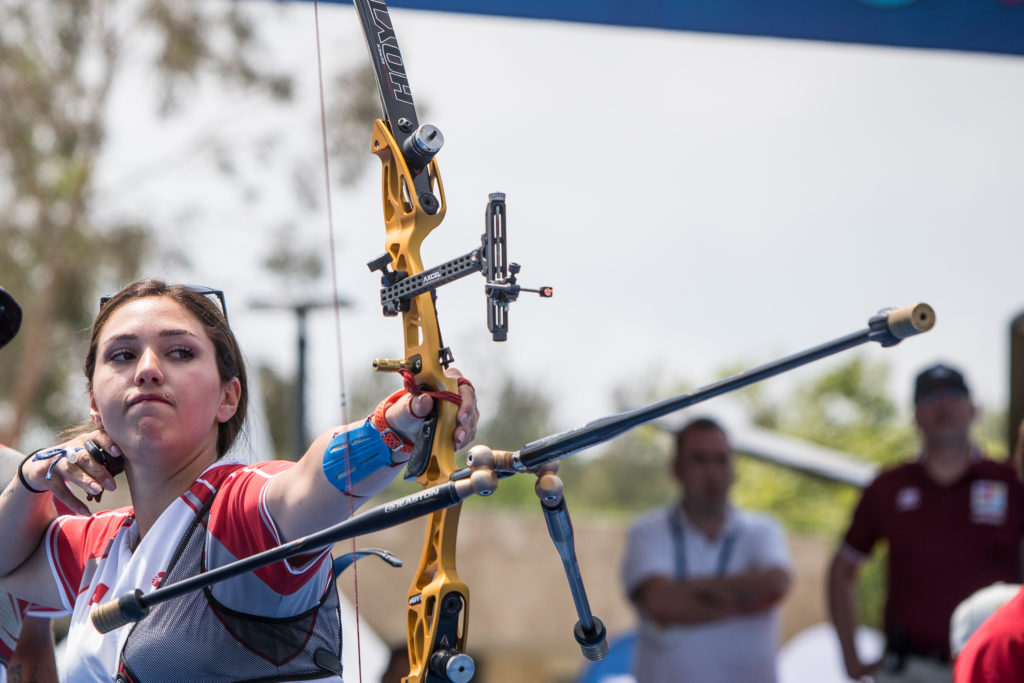
Andrew Smith weighs up your options.
Despite all the technical papers on recurve stabilisation, when you ask top coaches and archers about their stabilisation set up and how they arrived at their current configuration, all of them will say that it was achieved through trial and error.
Today there are many companies making stabilisers and associated products, varying wildly in price. The price difference is down to the materials used, production costs and the cost of the research and development deployed to make the finished article – as well as marketing. Most long and short rods are now made from carbon, or a mix of carbon and fibreglass as found at the cheaper end of the market.
Adding any stabilisation to a bow adds mass weight; how fit you are will determine how much weight you can add and ultimately the correct stabilisation configuration for you.
Unquestionably, stabilisation helps to increase scores – it is why every top archer uses them and not to do so will compromise your results. Most Olympic riser manufacturers expect an archer to add stabilisation and design the balance and centre of gravity (hereafter referred to as COG) to allow for it.
A well set-up stabilisation configuration helps to iron out minor form errors that create unwanted torque and movement of the bow, affecting arrow flight and lowering scores.
Today the most popular configuration trends are either a light or heavy set up, and which one works for you will depend on your shooting form and your fitness.
Where to start
When selecting a stabilisation solution, there is a big element of seeing what works, because a stabilisation system suitable for you cannot be set up in isolation from your bow, physical abilities and shooting form.
If you watch a lot of the top archers shooting or look along any shooting line you will see that the most popular configuration comprises of a longrod, v-bar, extender and two short rods with weights and rubber dampeners on the end of the rods.
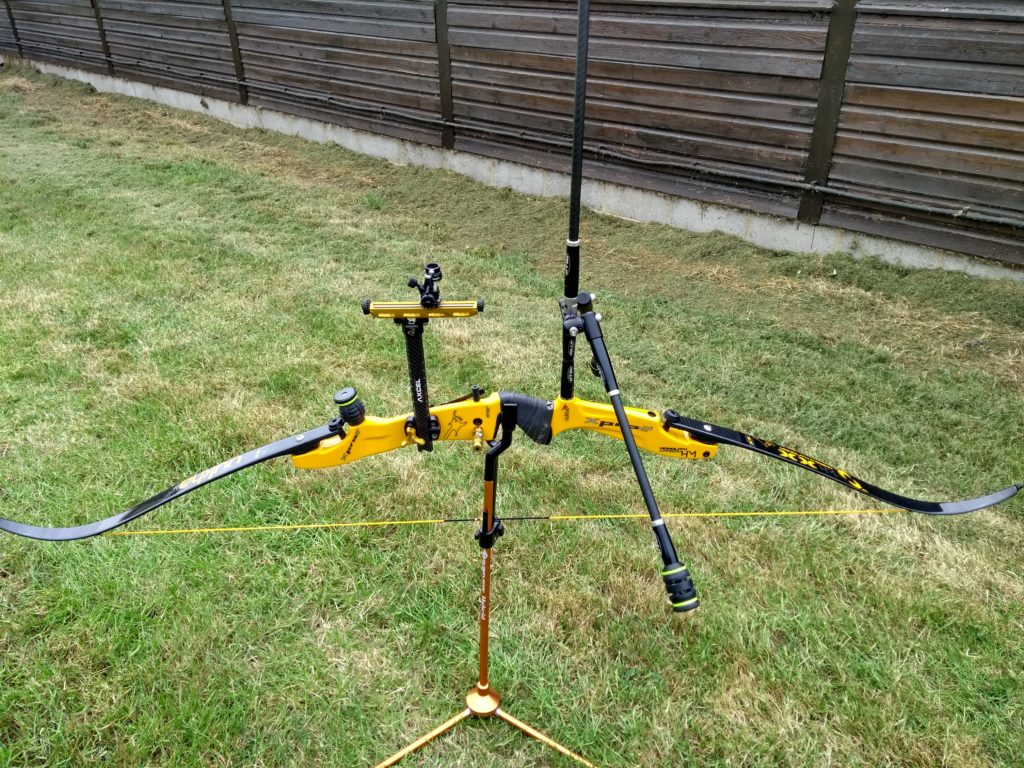
We will explore this in more detail later, but for the novice archer the best place to start is by adding a longrod. Most entry level rods come standard with a rubber dampener and a weight – if not, you will need to add these.
Using stabilisation will also require another piece of equipment: the finger or wrist sling. When most archers start out they grip the riser, this must be quickly unlearnt, and a better hand position is required that balances the riser in the hand, without creating any forces on it.
Shooting with stabilisers, you do not hold the bow, so the sling stops it falling to the floor after the shot.
We will always create some forces on the movement of the bow, but the longrod will create some resistance against this. As you draw the bow back, the limbs also move the centre of gravity of the bow towards the archer making it want to tip upwards.
The length of the longrod and the weight on the end will stop this from happening. All of this is important because any twisting or tilting of the riser after the release can interfere with arrow clearance and in extreme cases create arrow contact deflecting the arrow off-course.
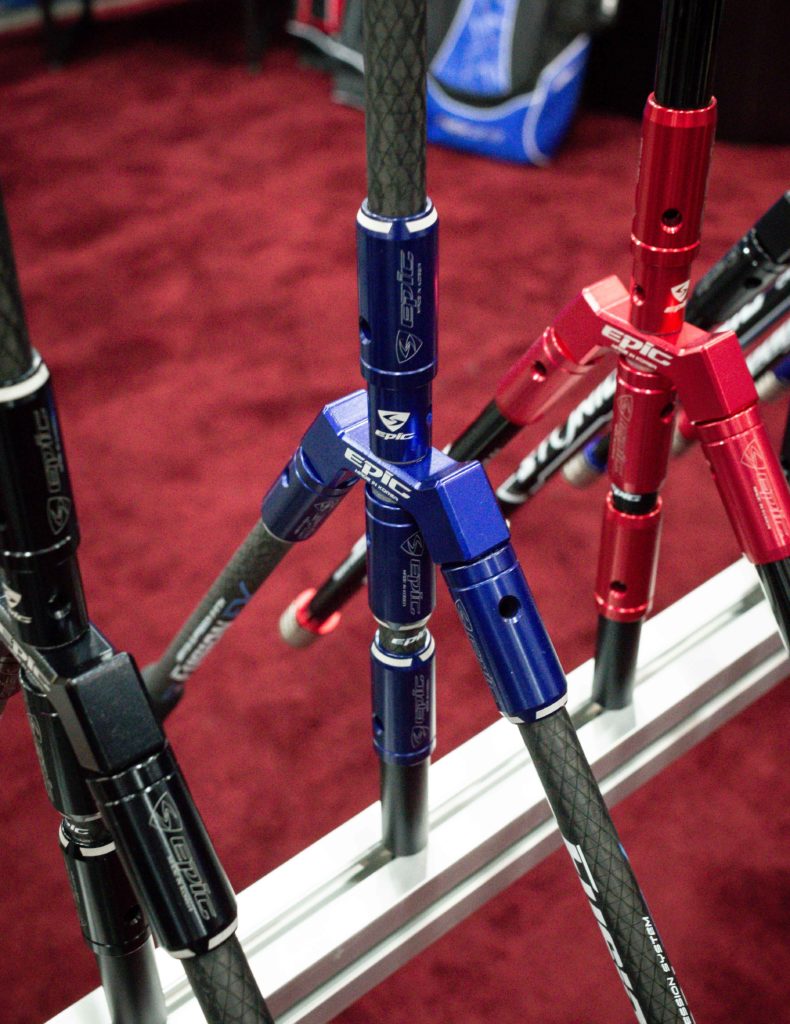
Longrods come in different lengths, from 26 inches to over 50 inches. Ideally you do not want it to be unwieldly, so as a guide: for draw lengths under 26″ go for a 26″ longrod, up to 28″, a 28″ longrod and for longer draw lengths a 30″ rod will be enough. With the addition of weights and a rubber dampener all the rods will end up being a bit longer.
At first, shooting with a longrod will feel strange as the balance will be different with the bow wanting to tip forwards. A mistake made by many is to add far too much weight to the end of the rod.
This creates problems with the control of the shot and bow set up as it changes the balance of the bow and the pressure point on the bow hand, which has an influence on the nocking point position and tiller.
At full draw you want the bow to feel settled, allowing the sight pin to hover over the gold and not feel like it wants to rotate downwards – or indeed, rise up – at any point during the shot cycle.
For beginners, a longrod will most definitely improve your scores, but it will also add mass weight to your bow. Care is needed to make sure your hips do not start to move forwards and the bow shoulder does not start to rise to compensate for this.
Once you have got familiar shooting with a longrod, you can start to consider adding a v-bar, extender and twin rods.
I suggest from experience using a 3″ or 4″ extender, as this will move the centre of gravity further forward without having to add lots of extra weight to the end of the longrod to get the same effect.
You will see many of the pros with slightly longer extenders; these are best tried when you have a bit more experience and full control of your shot.
Adding a v-bar and two short rods counteracts and balances some of the forward rotation of the bow so that the bow feels settled in the hand through the shot cycle. It will also reduce the rotation of the bow in the vertical plane so the bow will stay upright.
Most low-cost stabilisation sets these days include everything you need for around £80, although depending on hand position and accessories on the bow you may need to add an extra small weight on the short rod opposite to the sight fixing to balance the bow.
Once you have bolted everything to the bow, check to see if the bow has a good balance by balancing the extender on your finger with the bow upside down as shown on the right; this will give you a good starting point before you go and shoot.
It is difficult to shoot and feel whether the stabilisers are working for or against you. This is where the help of an experienced coach, archer and/or your local pro shop can help. They will have the skills to watch you shoot and see how the bow is reacting, and make any necessary changes to your form and bow set up.
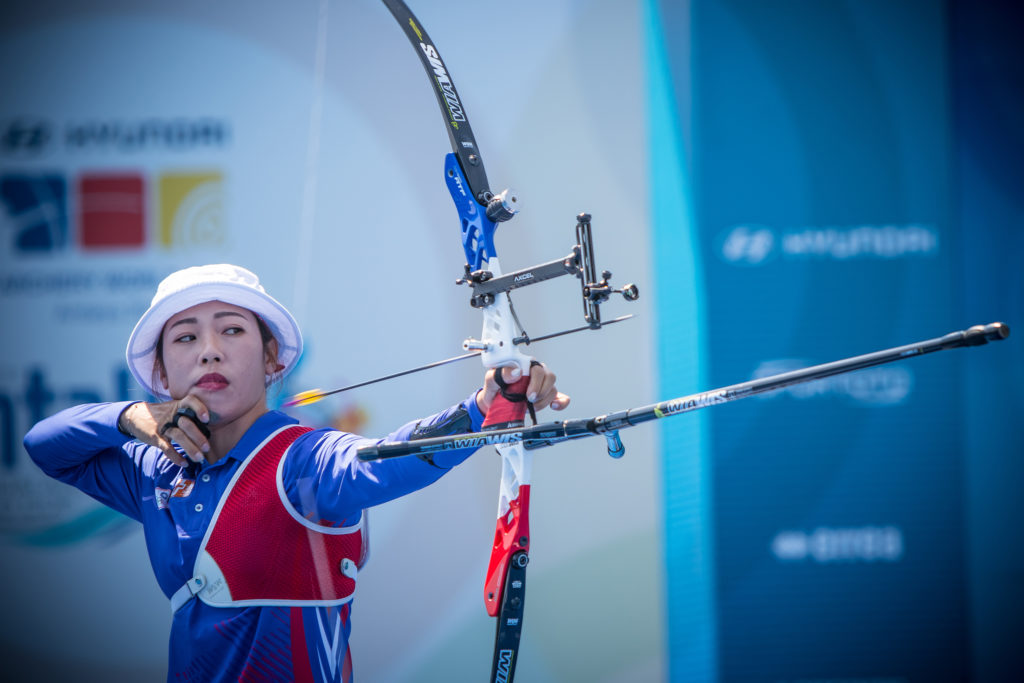
As a quick guide, your stabilisation at full draw should allow your sight to float over the gold and not want to drift away in any direction. Secondly, as you draw the bow back the longrod should not want to tip upwards. This is where a degree of trial and error is required with the adding or removing of weights, as everyone’s draw is unique.
There are many variations to the above mentioned ‘standard’ configuration. The most common include not using an extension bar and attaching the v-bar to the back of the riser either in line with the longrod or further down. Others will use an adjustable v-bar that allows you to change the angles of the short rods.
All of these are examples of trial and error by the archer and their coach – everyone is looking for those extra points. However, for the novice archer it is best to keep things simple. You can then use the time you would have taken fiddling to practice your form.
Upgrading your system
Anyone browsing on the internet will quickly notice that the choice is vast – along with the wide range of prices.
I am often asked: will a £150 longrod be better than one that costs £30? In terms of the primary function of a longrod to reduce hand torque, the answer is no.
But it is not as simple as that. We now have a multitude of materials used, different diameters and even shapes. All of these add secondary benefits such as help with bow vibration, how the rods react during the shot, stiffness, the look, and even their wind cheating properties.
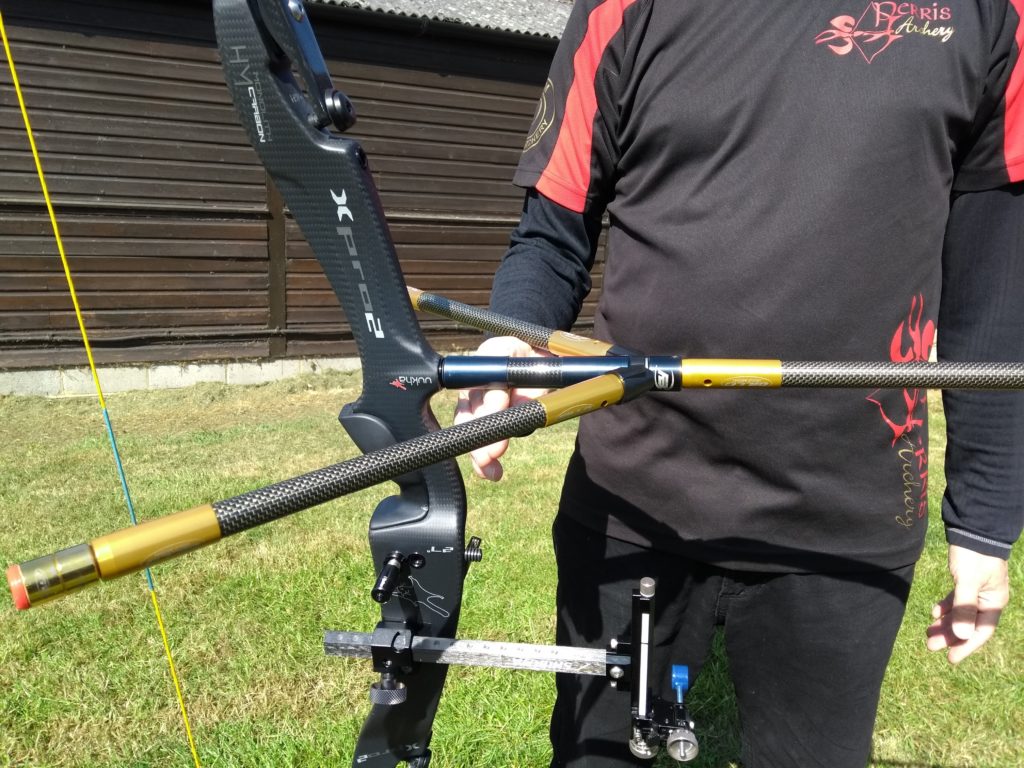
A popular trend is for stiffer and stiffer rods. This has big benefits for archers that like to pile lots of weight on the end of their rods, the stiffness reduces the flex and keeps the bow stable.
On the downside you can end up with a harsh or ‘dead’ feeling bow lacking in feedback, which can also be quite critical to a poor shot due to the lack of flexibility in the configuration. You will also have to be very fit to shoot with it.
Rods are also generally getting thinner in diameter, to lessen the effect of the wind, although for most club archers, the wind affects the archer more than the rotation properties of the stabilisation.
Most riser manufacturers produce stabiliser systems to match a riser model, usually colour co-ordinating with the risers. But in most cases, they will transfer and work on other manufacturers’ products. There are also a handful of dedicated manufacturers specialising in everything to do with stabilisation.
Which you choose is a personal choice; ideally you should try before you buy. But these days it is becoming difficult to find everything in one place as dealers are stocking less with the internet becoming more prominent. I always recommend that at the very least try the longrod on your setup as this has the biggest effect.
What do top archers use?
Most international archers fit into two categories, a light or a heavy set up and their choice of manufacturer is mostly down to sponsorship.These days, overall, a lighter set up is favoured by most international archers.
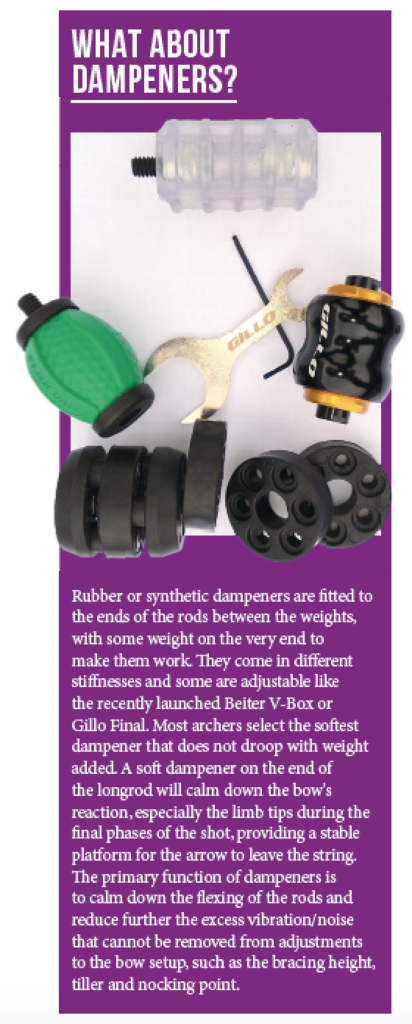
You will notice that the configurations are quite simple, with a rubber dampener and a small amount of weight at the ends. This configuration does not require the very stiff rods, just enough to not bend or flap around with the weight added.
Perhaps the biggest benefit is the ability to have more control in the wind, because when you are against the clock and the wind blows you off the gold it is easier to drift back. An added advantage of a lighter set up is that it reduces fatigue as the shot cycle can be quite quick.
A heavy set up, with lots of weight on the rods, feels very solid and stable keeping the sight pin hovering over the gold. Archers shooting this type of configuration need to be very fit and have a very definite, slower and controlled shot cycle.
Accessories
Weights
Manufacturers will make weights to complement their designs, the threads are typically 1/4″ (some stiffer rods us 5/16″), most are between 20g-40g and about a centimetre long.
This is fine if you have a light set up, but when adding lots of weight they do get rather long, the alternatives are heavier, bigger diameter weights known as disks, as used in most compound archery setups, which are slimmer to keep the overall length manageable.
Typically, a top archer’s lightweight set up will have around 140g on the longrod and 115g on each twin rod. A heavy set up could start at 300g and 250g respectively.
V-Bars
There are 2 types of v-bar, fixed or adjustable.
Adjustable v-bars allow you to set the vertical and horizontal positions of the short rods allowing you to get the bow rotation just as you like it.
Fixed v-bars are a solid bar in metal or carbon with no adjustment, so you buy the one that is suitable to your requirements. The most popular is a 0 x 45, where there is no vertical angle on the short rods, and they are set at 45 degrees to the riser. Others range from 30 to 40 degrees and 11 degrees down.
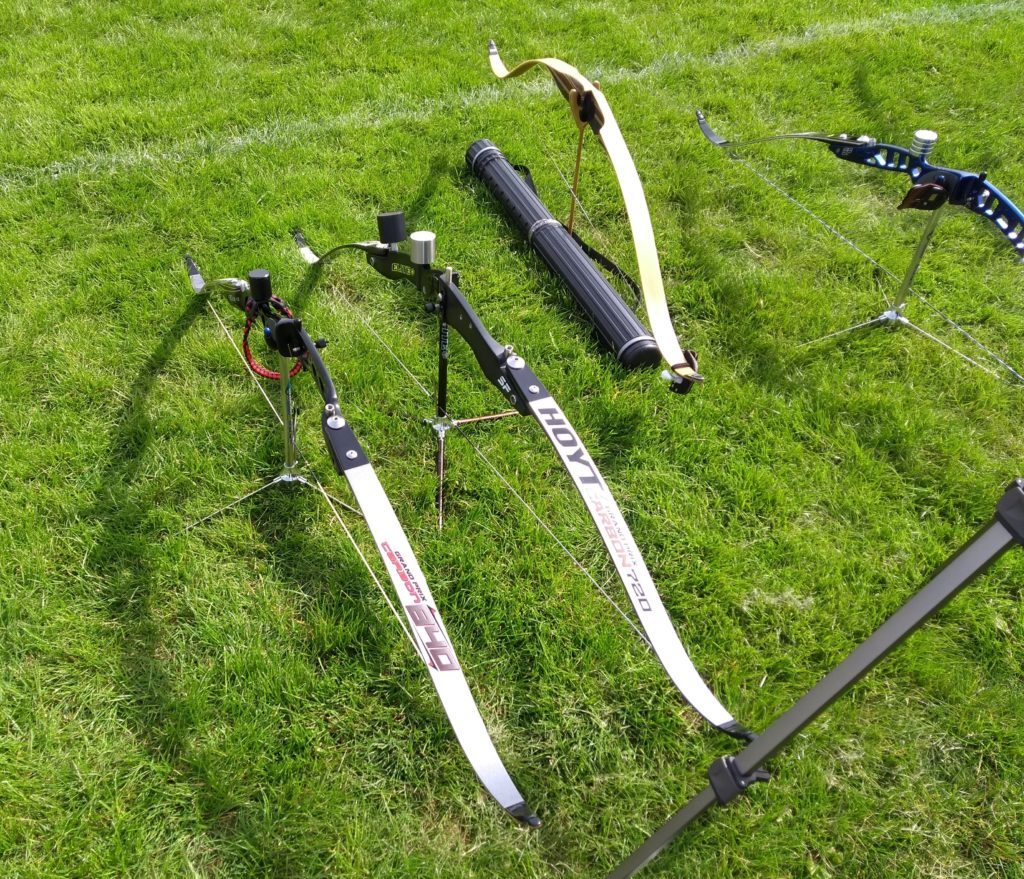
Top rods
A short top rod fitted just below the top limb pocket creates further resistance to the riser twisting, usually from 5″ to 10″ long. Many top archers describe adding this as much for ‘feel’ as anything else.
Riser weights
Risers these days come with a multitude of bushings to allow you to add additional mass weight to the riser, so if the riser is not heavy enough more weight can be added.
Typically, barebow archers, who are not allowed stabilisers, can add weight to the riser to help with the vertical balance and stop the bow tipping backwards, usually by adding weight to the bushing close to the bottom limb pocket.
Ultimately, time is required to find what best works for you, or if time is at a premium you cannot go far wrong by imitating the lighter setups favoured by most top archers – for example, the Korean international team. But if you aspire to tighter groups, adding the correct stabilisation to an Olympic recurve is essential.
Looking for a complete guide to compound bow stabilisation instead? We have that right here.


Compétition tir à l’arc
As a novice just dipping my toes in the ‘bow accessories’ minefield, I found this article to be of HUGE help. I’m and older chap (in my 60’s) and pretty new to this fabulous sport. I wish I’d found it 40 years ago. I shoot recurve off a 30lb pull, and am able to hit the gold at least once out of a set of 6 at 50m, so I’m hoping adding a long rod and a stabiliser system to my riser will add an extra gold or two to my sets.
Thank you. Very very helpful.